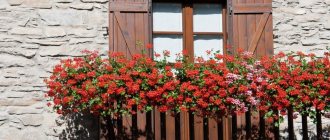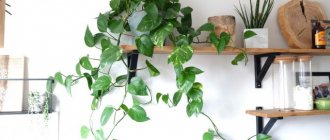Indoor plants have become such popular attributes that it is very difficult to imagine life without them. They not only decorate and enliven the interior, thereby motivating their owner to be productive.
But they also bring benefits, easing headaches and neutralizing not the most useful radiation emanating from under the gadget monitor. Flowers for the office help you work productively, saturate the air with oxygen, clearing harmful substances.
Let's try to figure out which flowers in pots are best suited for placement in the workplace and how they can help.
Dracaena
Another name for this plant, which belongs to the asparagus family, is dragon tree. A small palm tree (approximately 25 cm in size including pot) grows quite slowly and takes up very little space.
Dracaena is a unique filter for thoroughly cleaning the air in the area where it is located.
Thus, this plant is capable of cleaning a room by 70% from benzene, ammonia, formaldehyde and other harmful chemicals, which are often contained, for example, in low-quality flooring, upholstered furniture or various products made from synthetic materials.
Dracaenas are also recommended for absorbing radiation from computer monitors and household appliances. The plant can relieve headaches and relieve fatigue.
Photo gallery
Flowers that are suitable for office spaces are from the list above. Detailed galleries can be viewed in separate color sections.
Alpine violet
Alpine violet (Cyclamen purpurea) is a beautiful, neat and very delicate plant that pleases the eye with its appearance alone.
A small flower (size up to 25 cm) with flowers of pink shades, depending on the variety, can refresh the interior of the room all year round, inspiring work.
Previously, this plant was used for medicinal purposes: in the folk medicine cabinet there are various medicines (for the runny nose, diseases of the gastrointestinal tract, headaches, infectious diseases, hair loss and even snake bites) made on the basis of alpine violet.
At the moment, the plant is purchased exclusively for decorative purposes.
The following fact is also important: cyclamen is easy to care for: alpine violets need to be sprayed infrequently, and the optimal temperature is about +12 -+20°C, so these flowers are perfect for the office.
Decorating the office: what unpretentious flowers to choose for the work space
Office workers spend a significant part of their lives in a workplace that is not original, and is often completely boring and dull. But there is a great way that will help turn a nondescript space into a pleasing one, and that is fresh flowers. Of course, not every plant is suitable for this, and offices are different - somewhere there is more sunlight, somewhere artificial lighting predominates. Let's try to figure out how to transform your workspace without extra costs and hassle.
Ficus benjamina
Ficus Benjamin symbolizes nothing more than harmony, wisdom, health and fruitfulness in business, which is very important at work.
The energy of ficus relieves stress, normalizes internal state and helps to achieve inner harmony.
The plant is an evergreen tree or shrub that blooms only in the wild.
The plant is perfect for placement in the office, as it is very easy to care for: the shrub only needs watering twice a week in the summer, and once a week in the winter.
Recommendations
When choosing flowers for the office, remember that:
- Plants are living, which means improper care and a tense office atmosphere can lead to their death.
- Capricious flowers like roses, orchids or gloxinias are not very suitable for an office table.
- It is also better not to purchase cacti for the office, as they require special conditions in winter, which are difficult to fulfill in an office environment.
- If you decide to have plants, you should understand how difficult the New Year holidays, long breaks in watering, vandalism, and watering with leftover tea can be for them.
Bougainvillea
The pink flowering plant with lush clusters of bougainvillea is also known as "miracle flower". Triangular petals, evenly curling, attract the human eye.
The plant can often be found near holiday homes in tropical countries. Bougainvilleas are associated with warm summers, so their appearance alone dilutes the strict office atmosphere, adding bright and positive touches, helping not to dwell on pressing problems.
The birthplace of the miracle flower is sunny Brazil, so bougainvillea loves high humidity and spraying. From March to October, it is best to fertilize the plant with special fertilizers to strengthen it.
Begonia
Begonia is nothing more than a symbol of well-being. This plant is very common due to the fact that it absolutely does not require any special conditions for growth.
This bush can be found both in garden plots and in many apartments. Begonia feels great in any room, even with irregular care.
From an aesthetic point of view, the plant is not so attractive: it is a medium-sized bush with leaves of a unique color (from soft green to rich bronze shades).
However, one of the “superpowers” of begonia is the fact that its leaves secrete phytoncides that are able to cope with viruses and pathogens, thereby protecting against unpleasant colds.
Top best plants for the office
Sensevieria
Monstera
Zamioculcas
Saintpaulia
- Sensevieria , also called “mother-in-law’s tongue”, does not require specific living conditions, tolerates drought and drafts calmly, dense leaves are difficult to break, and damage is easily tolerated. Also, this flower calmly reacts to temperature changes and rare transplants. Their appearance is varied, the size ranges from large plants that are placed on the floor to small tabletop ones, and the color can be chosen from dark green to pale yellow-green.
- Monstera is a traditional plant for offices, hospitals and schools; it is durable and unpretentious; it is suitable for both natural and artificial light.
- Zamioculcas is gaining popularity as an office plant due to its beauty and unpretentiousness; even an uninsulated window sill will suit it, as it is not afraid of low temperatures.
- Saintpaulia or violet, unpretentious to the soil, capable of flowering even on dry stone soil. It has an attractive and varied appearance; you can choose double or semi-double flowers, large stars of flowers, stripes or small rosettes, of which a window sill can accommodate a whole collection.
Spathiphyllum
Bamboo
Chlorophytum
Dracaena
Dieffenbachia
Ficus benjamina - Spathiphyllum is a little capricious, but it copes better with air purification than other plants. All that is required is moderate but regular watering.
- Bamboo - instead of a pot with soil, it is constantly in a vessel with water, which needs to be topped up. It is quite unpretentious, looks good and especially suits the oriental style of the interior.
- Chlorophytum is very hardy and purifies the air better than other plants. It can last a whole month without water and does not need frequent transplants. Its lifespan reaches ten years.
- Dracaena or yucca comes from the Mexican desert, which indicates its immunity to temperature changes and drought. Its disadvantage is its high need for sunlight, which makes it unsuitable for living in dark rooms.
- Dieffenbachia needs intensive watering and abundant, but not direct, lighting. With its beauty and bright colors it can decorate any table.
- Ficus benjamina or rubber ficus has already become an office classic; it needs good lighting and moderate humidity, and purifies the air very well.
Codiaum (croton)
The name of the plant translated from Greek means “head”. This plant is also called “Joseph’s cloak.”
Codiaum helps cope with mental problems, stress and anxiety, and also has phytoremediation properties (the ability to purify indoor air from harmful substances).
A bush with bright burgundy leaves will give the room a special “tropical”, lively atmosphere. The plant is poisonous, so it is not recommended to plant codiaum at home, but it belongs in the office.
However, in any case, all work with the flower must be carried out using special protective gloves.
Vertical gardening
Vertical gardening is an ideal solution for spacious and small offices. In this case, the plants are planted in special wall structures. This method allows you to increase the number of flowers, practically without sacrificing usable space in favor of the flora.
IN THE PHOTO: Phytowall or “vertical garden”
All possible sizes of devices allow you to use both large surfaces ( phytowall ) and modest areas ( phytopicture ). They are not only stationary, but also mobile (phytomodules ). A separate pocket is provided for each plant, and both the use of soil and hydroponics cultivation are possible. It is extremely convenient that the lighting, watering and fertilizing systems in such a device are automated, that is, caring for flowers is limited to periodically pouring water into the tank. By the way, you can even evade this responsibility by providing a connection to the water supply and sewerage system.
The structures themselves are durable, and outdated plants can be easily replaced with new specimens.
Geranium
Geranium is a real amulet against negativity, gossip and negative energy, of which, you see, there is a lot at work. The plant is quite easy and unpretentious to care for.
Geranium has a wonderful sweetish, not cloying aroma, thereby helping to set its owner in a productive working mood and giving him a wonderful mood.
In addition, according to various esoteric stories, pelargonium (another name for geranium) attracts money and helps to gain financial stability.
Office trees: what are the options?
Tropical trees with large and original leaves are often used as floor decor. Such plants are placed in hallways, foyers, corridors and empty areas of spacious offices. Typically, trees and shrubs reach impressive sizes, so they need to be tied to a support and cleaned of dust from the leaves.
The most common include:
- Dracaena as a table decoration with an original palm-shaped crown.
- Ficus of any variety.
- Monstera is a floor giant that requires support.
- Lemon or other citrus trees.
- Hibiscus as a representative of decorative deciduous flowering plants.
All species have many varieties that differ in the shape and color of the leaves, but are also decorative, beautiful and unpretentious, and tolerate dry office climates well.
A rare phenomenon - a blooming monstera
Other plants for the office
Crassula arborescens
This plant is popularly known as the “money tree”. According to numerous reviews, the fat woman really helps to gain financial stability and success in business.
It is not advisable to keep this plant in the house: the leaves of the plant contain the dangerous poison arsenic. And although the substance does not evaporate and it is impossible to simply get poisoned even if you are nearby for a long time, children or pets are at risk.
If a restless child decides to bite off a plant, he will immediately begin to develop laryngeal edema, which leads to irreversible consequences, including death.
Nevertheless, the office is the perfect place for the tree crassula. The aesthetic component of this plant will decorate the room, moreover, the “money tree” is in no way inferior to aloe in its ability to clean the room.
Thanks to the volatile compounds from Crassula leaves, viruses and bacteria in the office will be completely neutralized.
Stylish minimalism
If the office is decorated in Japanese style, then the finishing touch will be a dwarf tree - bonsai. However, there are no restrictions on the use of such plants in other interiors. It is better to take an already formed tree. The most suitable place for bonsai, as a true evidence of respectability, is the manager’s office.
IN THE PHOTO: Bonsai for the boss
A fashionable trend in office landscaping is the use of florariums. Mini-gardens in glass vessels decorate the interior, content with rare watering or without it. In spacious rooms it is possible to install a large flower display.
A thoughtful approach to landscaping will give the office a unique look, create a friendly atmosphere and, ultimately, have a positive impact on business development.
Chinese rose
Another name for this plant is hibiscus. The Chinese rose is attractive in appearance, has a special charm and color, so it will decorate any room with its presence.
In addition to its aesthetic qualities, hibiscus helps to direct your own energy in the right direction and not pay attention to gossip and provocations.
The Chinese rose helps introverts become more open and free towards others, negotiate competently and attract people with positive energy.
Pothos (Epipremnum aureum)
Pothos has beautiful leaves
Pothos also goes well with Sansevieria!
Pothos is a green vine. There are several different types. There is golden pothos, marble pothos, neon pothos, Jessenia pothos and several other varieties. Each one has a different color and they basically have the same shape. Sometimes mistaken for a philodendron. This is my favorite plant that I can recommend to anyone who is new to the topic of floriculture. They are lenient towards water and light. Pothos is a good choice for an office, from the darkest office to a location near a window that is always in the sun.
Aglaonema
The evergreen shrub Aglaonema is popularly called the “flower of good luck.” This plant is very delicate and sensitive, so the leaves can turn yellow not only with improper or insufficient care, but also if placed in a room with an unpleasant and heavy atmosphere.
Aglaonema is an aeroid plant, which allows it to purify the air from bacteria (the leaves produce phytoncides) and absorb various harmful substances, and in return saturate the air with aero ions, which increase vitality and increase performance.
Where to put flowers in an apartment: tips
When starting landscaping, keep in mind that plants must be placed taking into account the peculiarities of their care and design rules. When choosing a place for permanent habitat, study the conditions that will be optimal for its development.
Flowering specimens often prefer a well-lit area; ferns and representatives of the dracaena family can thrive in shaded conditions.
How to place flowers on the windowsill?
The window sill remains the most common option for placing plants. Windows facing south, west or east are best suited for this. The north side will be a good solution for greenery that prefers shade.
The south side, constantly illuminated by bright sun, is an excellent option for succulents, cacti, oleander, and roses. On the western side, citrus fruits, tradescantia, and coffee will be comfortably located. Eastern - will become a cozy place for azaleas, dieffenbachia, fuchsia, and bulbous ones.
Placing flowers on the floor
Natural greenery will thrive on the floor as long as it is tall enough and receives the right amount of light. A large, heavy pot will make the flower unsafe if placed on a table or windowsill.
The best solution to place the plant on the floor is when purchasing decorative dwarf trees or tall vines. By placing them symmetrically near the door, you can add symmetry to the room, making them a group - moving part of the garden into the house.
Placing plants on a stand
Flowers with hanging branches and curved leaves deteriorate when placed on the surface of a windowsill, cabinet, or shelf. Their decorative effect is revealed only when using various stands. Hanging containers and floor structures allow you to create compositions in any part of the room.
When choosing an option for placing greenery, keep in mind that they can be:
- in the form of a miniature table on a leg;
- speakers made of wood, metal, smoky glass;
- rod holders made of forged metal, plastic, wood;
- grilles that help divide the room into zones.
Placing flowers on the walls
The wall turns into a green zone when it is necessary to create a bright accent in the room and give it individuality. To keep the air moist and not spoil the finish, select deep vessels equipped with a capacious tray.
Flowers in the living room, the design of which you plan in advance, should be in harmony with the surface on which they will be placed:
- Lush greenery and bright flowers will look great on delicate, pastel surfaces. Plants with variegated leaves and numerous pale flowers will be lost against such a background, but will look great on a dark wall.
- Avoid specimens with small leaves if you choose a wall with a small pattern as the background. Species with large, spreading foliage will look great on it.
- Combine contrasts and shapes. A strict vertical pattern will enliven a luxurious climbing plant.
Monstera
Monstera is a large vine (approximately 40-60 cm) with slightly perforated leaves native to the tropics. The plant is popular for the office because of its ease of care.
Monsteras are rarely planted in apartments: the enormous size to which the plant can grow in the future (up to the ceiling) is often repulsive and frightening. Nevertheless, for decorative purposes the monstera looks very harmonious.
Flowers for the office regularly supply the air with oxygen and are purely aesthetically pleasing to the eye, helping not to get hung up on pressing problems and to perceive situations more easily.
All plants from the TOP can be purchased on the website flowwow.com - a Russian online platform for posting, searching and purchasing flowers and gift items.
Posting rules
Flowers in offices perform not only a practical role (purifying the air and saturating it with oxygen), but also an aesthetic one:
- They must fit correctly into the interior in order to form a single composition, which will not only be useful for mobilizing the labor resources of employees, but also for their short-term relaxation during smoke breaks and lunch.
- The lack of green flower islands in the office impoverishes it, turning it into a stone cage, but an overabundance is also unacceptable.
- With a large number of plants, the office will become like a winter garden or greenhouse, turning it not into a work organization, but into a relaxation area. Everything should be in moderation.
- The location of the flowers is also important. Large office plants are usually placed in reception areas, waiting rooms, and executive offices. They look organic there. Small ones are placed on employee desks, window sills, and flower racks.
You should not place flower pots near radiators, under air conditioners, or in drafts. It's bad for them.
Flowers for the office are a piece of life-giving nature in the urban concrete jungle. Ideally, they should exude a light, unobtrusive aroma, fit into the interior, and require a minimum of care.











